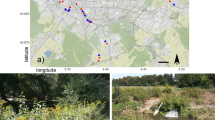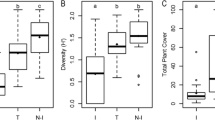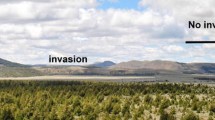Abstract
In central Chile, the bur beak chervil (Anthriscus caucalis M. Bieb.; Apiaceae) is an annual naturalized herb introduced from Europe at least 120 years ago. Anthriscus is distributed in vegetation formations such as sclerophyllous shrublands (locally known as “matorral”) and spiny savannas of Acacia caven (locally known as “espinal”). In matorral formations, Anthriscus grows at the edge of native woody fragments. Because these fragments are refuges where native herbs recruit, we studied the impact of Anthriscus on the diversity and survival of native forbs established in these sheltering microsites. First, we characterized the spatial distribution of Anthriscus in the matorral, sampling in different micro-habitat types. We differentiated three microhabitat types: under the canopy of a fragment, at the edge of the canopy of a fragment, and in open sites outside the fragments. A total of 40 1 × 1 m quadrates were randomly distributed in each habitat type. Inside each of them, we recorded the number of seedlings and established plants, including Anthriscus. Then we evaluated experimentally the effect of Anthriscus on diversity and evenness of the local herb assemblages. For this purpose we conducted a field trial using 34 metallic enclosures (0.5 × 0.5 m) arranged in pairs. In each pair, Anthriscus individuals were removed from one plot, the other paired plot acting as control. We periodically recorded the presence and abundance of the remanent species of herbs inside the plots, and then we characterized the species diversity and evenness over time (Shannon’s index, H′ and Pielou’s index, J′). Finally, in a second experiment we measured experimentally the presence or absence of Anthriscus against the survival of four native herb species (Bowlesia incana, Bromus berteroanus, Pectocarya linearis, and Moscharia pinnatifida). Here we used 20 0.5 × 0.5 m plots where we randomly transplanted seedlings of native herbs and Arnthiscus. Then, for each species and plot we determined their survival (%) according to the number of seedlings initially transplanted. The samplings show strong association between the presence of Anthriscus on edge habitat in the matorral. The maximum densities were noted in these microhabitat types whereas in open areas and under-fragment sites Anthriscus shows very low or null densities. At the end of the first trials, the plots with Anthriscus showed a Shannon diversity index H′ = 0.41 (±0.11 SE), while in plots without Anthriscus this value was 1.19 (±0.1 SE), both as averages. Pielou’s evenness index (J′) yielded values of 0.23 (±0.06 SE) and 0.59 (±0.04 SE) for treatments with and without Anthriscus, respectively. Similarly, the second trials shows that the survival of the four native herbs was drastically decreased in the presence of Anthriscus: by 64% for Bowlesia incana, 43% for Bromus berteroanus, 46% for Moscharia pinnatifida, and 76% for Pectocaria linearis. Our study shows that the effects of Anthriscus include an inhibition of the establishment of native plants and a decrease in their survival in edge habitats, therefore affecting the composition and diversity of the local herb layer. Thus, Anthriscus is invading a refuge habitat for native herbs in the Chilean matorral, decreasing the native herb diversity and survival.




Similar content being viewed by others
References
Armesto JJ, Vidiella PE, Jiménez HE (1995) Evaluating causes and mechanisms of succession in the mediterranean regions in Chile and California. In: Arroyo MTK, Zedler PH, Fox MD (eds) Ecology and biogeography of mediterranean ecosystems in Chile, California, and Australia. Springer-Verlag, New York, pp 418–433
Aronson J, del Pozo A, Ovalle C, Avendaño J, Lavín A, Etienne M (1998) Land use changes and conflicts in central Chile. In: Rundel PW, Montenegro G, Jaksic FM (eds) Landscape degradation and biodiversity in mediterranean-type ecosystems. Springer-Verlag, Berlin, pp 155–168
Arroyo MTK, Marquet P, Marticorena C, Simonetti JA, Cavieres LA, Squeo FA, Rozzi R, Massardo F (2006) El hotspot chileno de biodiversidad, una prioridad mundial para la conservación. In: Saball P, Arroyo MTK, Castilla JC, Estades C, Ladrón de Guevara JM, Larraín S, Moreno C, Rivas F, Rovira J, Sánchez A, Sierralta L (eds) Biodiversidad de Chile: patrimonio y desafios. Comisión Nacional del Medio Ambiente, Santiago, pp 94–99
Baskin CC, Baskin JM (1998) Seeds: ecology, biogeography, and evolution of dormancy and germination. Academic Press, San Diego
Cowling RM, Rundel PW, Lamont BB, Arroyo MK, Arianoutsou M (1996) Plant diversity in mediterranean-climate regions. Trends Ecol Evol 11:362–366
D’Antonio CM, Hobbie S (2005) Plant species effects on ecosystem processes: insights from invasive species. In: Sax D, Stackowich J, Gaines S (eds) Insights from invasive species. Sinauer, Sunderland, pp 65–84
del Pozo A, Fuentes E, Hajek ER, Molina J (1989) Microclima y manchones de vegetación. Rev Chil Hist Nat 62:85–94
di Castri F (1981) Mediterranean-type shrublands of the world. In: di Castri F, Goodall DW, Specht RL (eds) Mediterranean-type shrublands. Elsevier, New York, pp 1–52
di Castri F, Hajek ER (1976) Bioclimatología de Chile. Ediciones Universidad Católica de Chile, Santiago
Dukes JS, Mooney HA (2004) Disruption of ecosystem processes in western North America by invasive species. Revista Chilena de Historia Natural 77:411–437
Figueroa JA, Jaksic FM (2004) Latencia y banco de semillas en plantas de la región mediterránea de Chile central. Rev Chil Hist Nat 77:201–215
Figueroa JA, Teillier S, Jaksic FM (2004) Composition, size and dynamics of the seed bank in a mediterranean shrubland of Chile. Austral Ecol 29:574–584
Fuentes ER, Jaksic FM, Simonetti JA (1983) European rabbits versus native rodents in central Chile: effects on shrub seedlings. Oecologia 58:411–414
Fuentes ER, Otaíza RD, Alliende MC, Hoffmann AJ, Poiani A (1984) Shrub clumps of the Chilean matorral vegetation: structure and possible maintenance mechanisms. Oecologia 62:405–411
Fuentes ER, Hoffmann AJ, Poiani A, Alliende MC (1986) Vegetation change in large clearing: patterns in the Chilean matorral. Oecologia 68:358–366
Gelbard JL, Harrison S (2003) Roadless habitats as refuges for native grasslands: interactions with soil, aspect, and grazing. Ecol Appl 13:404–415
Gram WK, Borer ET, Cottingham KL, Seabloom EW, Boucher VL, Goldwasser L, Micheli F, Kendal BE, Burton RS (2004) Distribution of plants in a California serpentine grassland: are rocky hummocks spatial refuges for native species? Plant Ecol 172:159–171
Gulmon SL (1977) A comparative study of the grasslands of California and Chile. Flora 166:261–278
Harrison S (1997) How natural habitat patchiness affects the distribution of diversity in Californian serpentine chaparral. Ecology 78:1898–1906
Harrison S (1999) Local and regional diversity in a patchy landscape: native, alien, and endemic herbs on serpentine. Ecology 80:70–80
Holmgren M (2002) Exotic herbivores as drivers of plant invasions and switch to ecosystem alternative states. Biol Inv 4:25–33
Holmgren M, Avilés R, Sierralta L, Segura AM, Fuentes ER (2000) Why have European herbs so successfully invaded the Chilean matorral? Effects of herbivory, soil nutrients, and fire. J Arid Envir 44:197–211
Jaksic FM (2001) Spatiotemporal variation patterns of plants and animals in San Carlos de Apoquindo, central Chile. Rev Chil Hist Nat 74:477–502
Jaksic FM, Fuentes ER (1980) Why are native herbs in the chilean matorral more abundant beneath bushes: microclimate or grazing? J Ecol 68:665–669
Jiménez A, Pauchard A, Cavieres LA, Marticorena A, Bustamante RO (2007) Do climatically similar regions contain similar alien floras? A comparison between the mediterranean areas of central Chile and California. J Biogeogr 35:614–624
Kaplan EL, Meier P (1958) Nonparametric estimation from incomplete observations. J Am Stat Assoc 53:457–481
Keeley SC, Johnson AW (1977) A comparison of the pattern of herb and shrub growth in comparable sites in Chile and California. Am Midl Nat 97:120–132
Lee ET, Desu MM, Gehan EA (1975) A Monte Carlo study of the power of some two-sample tests. Biometrika 62:425–432
Levine JM, Vila M, D’Antonio CM, Dukes JS, Grigulis K, Lavorel S (2003) Mechanisms underlying the impacts of exotic plant invasion. Proc Roy Soc Lond B 270:775–781
Lonsdale WM (1999) Global patterns of plant invasions and the concept of invasibility. Ecology 80:1522–1536
Matthei O (1995) Manual de las malezas que crecen en Chile. Alfabeta impresores, Santiago
Montenegro G, Teillier S, Arce P, Poblete V (1991) Introduction of plants into the mediterranean-type climate area of Chile. In: Groves H, di Castri F (eds) Biogeography of mediterranean invasions. Cambridge University Press, New York, pp 103–114
Murphy DD, Ehrlich PR (1989) Conservation biology of California’s remnant grasslands. In: Huenneke LF, Mooney H (eds) Grassland structure and function: California annual grassland. Kluwer Academic Publishers, Dordrecht, pp 201–211
Myers N, Mittermeier RA, Mittermeier CG, Da Fonseca GAB, Kent J (2000) Biodiversity hotspots for conservation priorities. Nature 403:853–858
Pauchard A, Cavieres LA, Bustamante RO (2004) Comparing alien plant invasions among regions with similar climates: where to from here? Divers Distrib 10:371–375
Randall RP (2002) A global compendium of weeds. RG, FJ Richardson, Merredith, Victoria
Reiche K (1899) Estudios críticos sobre la flora de Chile. Anales de la Universidad de Chile 104:767–847
Rozzi R, Molina JD, Miranda P (1989) Microclima y períodos de floración en laderas de exposición ecuatorial y polar en los Andes de Chile central. Revista Chilena de Historia Natural 62:74–85
Rundel PW (1981) The matorral zone of central Chile. In: di Castri F, Goodall FD (eds) Mediterranean type shrublands. Elsevier, New York, pp 175–201
Rundel PW (1998) Landscape disturbance in mediterranean-type ecosystems: a review. In: Rundel PW, Montenegro G, Jaksic FM (eds) Landscape degradation and biodiversity in mediterranean-type ecosystems. Springer-Verlag, Berlin, pp 3–22
Sax DF (2002) Native and naturalized plant diversity are positively correlated in scrub communities of California and Chile. Divers Distrib 8:193–210
Sokal RR, Rohlf FJ (1995) Biometry, 3rd edn. WH Freeman and Co. New York, New York
Stohlgren TJ, Otsuki Y, Villa CA, Lee M, Belnap J (2001) Patterns of plant invasions: a case example in native species hotspots and rare habitats. Biol Invasions 3:37–50
Theoharies KA, Dukes JS (2007) Plant invasion across space and time: factors affecting nonindigenous species success during four stages of invasion. New Phytol 176:256–273
Tutin TG, Heywood VH, Burges NA, Moore DM, Valentine DH, Walters SM, Webb DA (1968) Flora Europaea, vol 2: Rosaceae to Umbelliferae. Cambridge University Press, Cambridge
Vitousek PM, D’Antonio CM, Loope LL, Westbrooks R (1996) Biological invasions as global environmental change. Am Sci 84:468–478
Williamson M (1996) Biological invasions. Chapman and Hall, London
Acknowledgments
This study was partially funded by the A. W. Mellon Foundation and the Center for Advanced Studies in Ecology and Biogeography (CASEB). Sergio Castro is also grateful to FONDECYT 3060015 and 11085013.
Author information
Authors and Affiliations
Corresponding author
Rights and permissions
About this article
Cite this article
Castro, S.A., Badano, E., Guzman, D. et al. Biological invasion of a refuge habitat: Anthriscus caucalis (Apiaceae) decreases diversity, evenness, and survival of native herbs in the Chilean matorral. Biol Invasions 12, 1295–1303 (2010). https://doi.org/10.1007/s10530-009-9547-8
Received:
Accepted:
Published:
Issue Date:
DOI: https://doi.org/10.1007/s10530-009-9547-8




